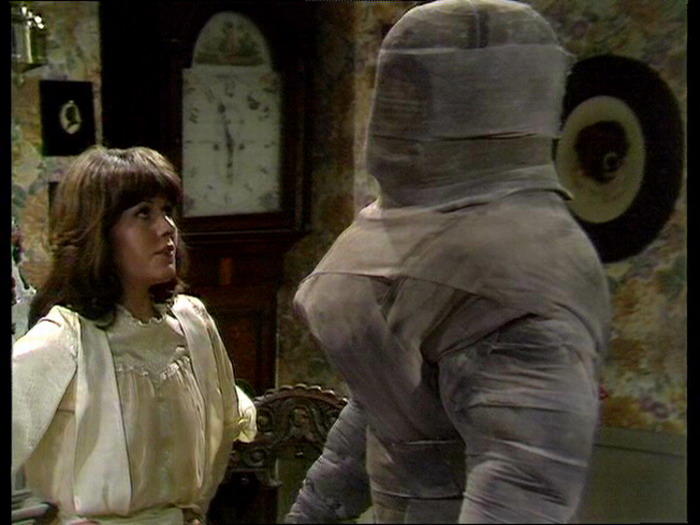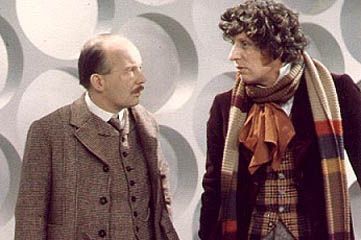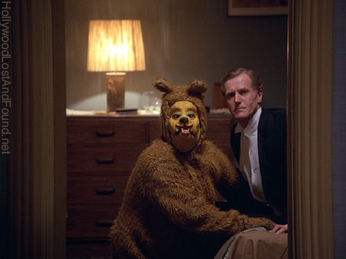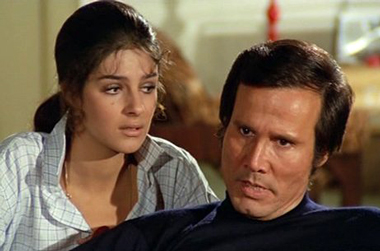 |
| Apparently, Philip Hinchcliffe had one last nightmare in store before Sarah Jane before bidding her farewell... |
"Sometimes."
"Can you tell mine?"
"No."
"Why not?"
"Because you don't have future unless you listen to me."
1) I honestly didn't realize that this serial was shot at Portmerrien of The Prisoner and Fawlty Towers fame until the documentary pointed this out. The way the story is shot, coupled with the usual gorgeous BBC period interiors and costumes in the other scenes, create a legitimate atmosphere for what has to be one of the most atmospheric stories in the Hinchcliffe run.
2) This, the penultimate story in Elisabeth Sladen's initial tenure as Sarah Jane Smith, does not give her much to do....in fact, there's little for either her or the Doctor to do for long stretches of the tale. But writer Louis Marks (an expert in the Renaissance) has created such an engaging tale that we don't notice that our heroes have disappeared for stretches of time.
3) One of the clever elements in this story is how we're led to believe that the villain is John Laurimore's gloriously scenery chewing Count Frederico---when the real nasty customer is Norman Jones' Heironymous, who is deliciously mean and manipulative...leading to Frederico having something of a 'face turn' in the very end, just long enough for Heironymous to consume him with helix energy.
4) Yes, the Cult of Mandragora's appearance is rather primative in their optically goodness, but the simpleness of the Cult being so consumed that all that's left is glowing yellowish-orange light occupying their robes is highly effective. Plus the shots of Heironymous' mask, the glow shining through the holes, are really, really cool.
5) Especially given that Sarah Jane leaves this season, I greatly like the fact that the script plays with the idea that Gareth Armstrong's Guiliano seriously crushes on Sarah but never follows it to the conclusion that kills the story arc of so many of the companion. Hell, one of my favorite scenes involves Guiliano trying to impress Sarah with his theories about the Earth being round.
 |
| "I rather like this control room. I think I'll keep it until, I don't know, a new producer decides he doesn't like it..." |
6) Once more, we get Philip Hinchcliffe giving us little fiddly bits that enhance the greater mythology of Who. The whole sequence introducing the new control room features shout backs to both the Third and Second Doctor that implies some untold stories. Plus we have the genius moment where The Doctor susses out that Sarah has been hypnotized by Heironymous because she wonders why she can understand Italian which leads to an explanation as to why everyone seems to speak English in the Whoniverse (namely that he gifts all his companions with the ability to telepathically understand languages). It's the sort of thing that only Hinchcliffe seems to be able to do with subtlety and grace.
7) This is the serial that introduces what is easily my favorite iteration of the Tardis control room. I love this set! Baker seems totally at home in this set, which also seems to emphasize that this is a being separate from time and space. The set is only used for this season, and depending on who you listen to it was junked because either the sets warped in storage, or because Graham Williams thought it wasn't 'sci-fi' enough. If the reason is the later, Graham Williams needs to be kicked in the ass repeatedly, and it's another reason I don't care for his tenure.
 |
| One of the charms of this serial is the realization that the real bad guy is the one who looks like the sidekick... |
8) Once more, there are these little grace notes provided by the overwhelming chemistry between Baker and Sladen. The thing that really is driven home is how, even though Sarah spends a little too much time as either a hostage or a mind controlled pawn, she is integral to setting the final act in motion, acts as a mediator between the Doctor and other characters and--most importantly--calls the Doctor on the carpet when he's busy goofing off with the suggested costumes Guliano gives him. Plus the interplay in the opening episode of the story, where she is wandering the Tardis with The Doctor, is priceless.
9) I really have to wonder if Tom Baker secretly dreams of being Errol Flynn or Douglas Fairbanks--this story shows us a very physical Doctor, riding horses, engaging in sword fights, and otherwise acting like a dashing rogue. It's obvious that there are portions of the sword fight he has with Frederico's men which uses a stand-in, but a couple of shots are obviously Baker, and you can see the joy on his face when he's doing this stuff.
10) I was a little confused by the Madragora Helix's behavior in the serial. There's this sense in the first part and change that the Helix is just some rogue, runaway monstrosity cutting an out of control swath...it's not until the Helix has contact with Hieronymous' that it starts to show not only a form of intelligence, but a heightened example of same. It's like those first appearances are there to remind us that there is a supernatural component to the tale. The story might hang together better if they had treated those early appearances of the Helix better.
Overall...a wonderful last hurrah before one of the greatest alliances in Who history is dissolved, this has all of the Hinchcliffe elements, plus some great performances. Recommended.



























